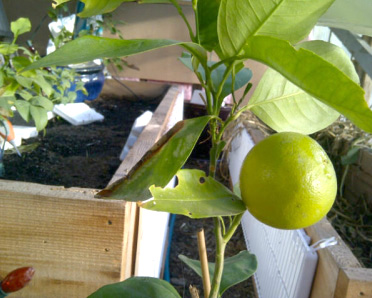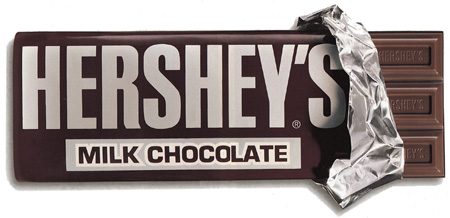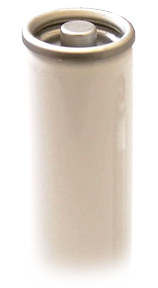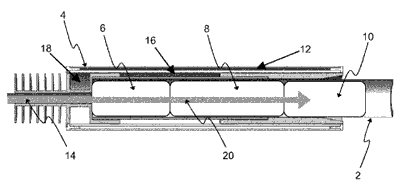 The Phase Change Matters e-mail newsletter is a weekly summary of the latest news and research on phase change materials and thermal energy storage. To subscribe, visit www.puretemp.com/subscribe. For more frequent updates, follow @puretemp on Twitter or visit the Phase Change Matters blog, www.puretemp.com/pcmatters.
The Phase Change Matters e-mail newsletter is a weekly summary of the latest news and research on phase change materials and thermal energy storage. To subscribe, visit www.puretemp.com/subscribe. For more frequent updates, follow @puretemp on Twitter or visit the Phase Change Matters blog, www.puretemp.com/pcmatters.
AGRICULTURE
PCMs show promise in citrus greenhouse in Canada
Becky Mason put phase change material to the test at Carmenia Farm in Duncan, British Columbia, last year. The goal: Keep her 200-square-foot greenhouse running all winter, using the heat of the sun to grow lemons, limes and avocados without electricity.
 After securing government funding to support the project, she ordered eutectic salts from PCM maker RGEES of Arden, N.C. The PCM has a melt point of 6º C and a storage capacity of 260 joules per gram. She deployed the PCM in 89 1-liter bottles stacked around the raised beds in the greenhouse. She disconnected the strings of incandescent lights that had kept the trees warm the previous winter. The initial result? Not good. When the temperature plummeted outside, it also plummeted inside, falling to -4º C. Her fruit suffered frost burn. The PCM had failed to recharge.
After securing government funding to support the project, she ordered eutectic salts from PCM maker RGEES of Arden, N.C. The PCM has a melt point of 6º C and a storage capacity of 260 joules per gram. She deployed the PCM in 89 1-liter bottles stacked around the raised beds in the greenhouse. She disconnected the strings of incandescent lights that had kept the trees warm the previous winter. The initial result? Not good. When the temperature plummeted outside, it also plummeted inside, falling to -4º C. Her fruit suffered frost burn. The PCM had failed to recharge.
Writing in Small Farm Canada, Mason explains how she addressed the problem by adding insulation, placing the PCM bottles side-by-side and putting a barrel of water in the greenhouse to provide a reserve of thermal energy to help the PCM recharge. In the end, she found the results encouraging:
“Based on advice from the manufacturer and other project partners, I tried a number of fixes, until at last the PCM product worked as intended by early January of 2015. From early January through the end of April, when the data collection ended, the PCM kept the inside of the greenhouse continually above 32F (O Celsius), even when the outside temperature went below freezing on over 20F (-6C) nights, sometimes as low as 26F (-3C). Even more significantly, the soil temperature never went below 50F (10C) throughout the entire trial period. Despite the early setbacks, all of the citrus, as well as the avocado tree, made it through the winter and are flourishing. Winter production with an air temperature above freezing and a 50F (10C) soil temperature offers year round farming.”
EDUCATION
InPath TES seeks feedback on joint Ph.D. program on thermal energy storage
InPath TES, Europe’s joint Ph.D. program on thermal energy storage, is looking for feedback. A three-minute online survey is designed to help the new organization shape plans to develop a doctoral program on thermal energy storage technologies at a network of universities and research institutes.
Partners include Trinity College Dublin, Technical University of Eindhoven, University of Ghent, Warsaw University of Technology, Abengoa Research and KIC InnoEnergy. Core objectives include annual workshops, common training modules and academic/industry student exchanges. Within six years, the group hopes to graduate at least 28 Ph.D. students a year.
InPath TES distributed its second newsletter this month. It features profiles of four recent Ph.D. graduates and two of the group’s partners, appliance-maker Arçelik and the University of Lleida’s multidisciplinary GREA group.
BUSINESS OPPORTUNITY

Help wanted: A better way to ship chocolate at the ideal temperature
Every chocolate lover knows: Extreme heat and cold can ruin a perfectly delicious chocolate bar. The Hershey Co. has launched a contest to develop a lightweight shipping system that will keep chocolate close to the temperature at which it was packed, 24° Celsius (75°F) or below, for at least 48 hours. The goal is to develop a system inexpensive enough to use year round as part of the standard packaging for small parcel shipments.
The contest represents an opportunity to become a collaborator/supplier to Hershey. In the first round of the competition, up to five groups will be selected to provide prototypes of their technologies. Each finalist will receive $10,000 for prototype development. The group submitting the top-ranked prototype will receive $25,000 in additional development funds.
Successful technologies will:
• Maintain packaged chocolate temperatures at or below 75°F for 48-72 hours
• Be less than three years from commercialization
• Operate without pre-freezing of components
• Prevent chocolate from freezing
• Contain materials approved for food contact
• Contain chemical components that are generally regarded as safe
• Be adaptable to different-size shipments
• Have a price point that is compatible with consumer shipments of chocolate candy bars
• Be comparable or less in size and weight with current cold shipping systems
Entries are due Feb. 15, 2016.

NEW PRODUCTS
TubeVesl cylinder added to Vesl line
of PCM containment devices
In partnership with Entropy Solutions, Vesl LLC has added TubeVesl to its line of PCM containment devices.
The metal cylinders are hermetically sealed and able to withstand extremely high temperatures and high pressures. An aluminum coating is designed to resist corrosion. Each cylinder is 30mm in diameter and 165mm in height. Each holds 100g (3.5 ounces) of PureTemp phase change material, available in a wide range of temperatures, from -37°C (-34°F) to 151°C (304°F).
PATENTS
Temperature change compositions and tissue products with cooling sensation
U.S. patent application 20160022553 (applicant Kimberly-Clark Worldwide Inc., Neenah, Wis.)
“Wiping products, such as facial tissues, contain a temperature change composition that can provide a cooling sensation when contacted with the skin of a user. The temperature change composition is structured emulsion that may include a phase change material, a carrier, a surfactant, and a crystalline initiator. The phase change materials, in one embodiment, can have a relatively high heat of fusion. When undergoing a phase change, the temperature change composition absorbs heat and thereby provides a cooling feeling or cooling sensation to the skin of a user.”
Aerosol-generating device comprising solid-liquid phase change materials

U.S. patent application 20160021932 (applicant Philip Morris Products SA, Neuchatel, Switzerland):
“An aerosol-generating device is provided, for use in an aerosol-generating system and an aerosol-generating system including an aerosol-generating device and an aerosol-generating article. The aerosol-generating device includes a cavity configured to receive an aerosol-generating article; a first solid-liquid phase-change material positioned about a perimeter of the cavity; and heating means configured to heat the first solid-liquid phase-change material to a temperature above the melting point of the first solid-liquid phase-change material. The aerosol-generating device further includes a second solid-liquid phase-change material, wherein the melting point of the second solid-liquid phase-change material is higher than the melting point of the first solid-liquid phase-change material.”
IN BRIEF
• CleanTechnica takes a look at the DuPont-ADM “breakthrough” process for producing a high-performance, 100 percent biodegradable bioplastic. The companies’ first project will use furan dicarboxylic methyl ester to produce polytrimethylene furandicarboxylate, which ADM says outperforms petroleum-based polymers in extending beverage shelf life.
• Tempur-Pedic has revamped its Breeze line of cooler-sleep beds, fusing phase change material in the top Tempur foam layer to deliver “a significantly improved cooling effect,” the company said.
• Composite sandwich panels containing phase change material are among 20 smart materials and structures identified by a European Union study with possible applications in the shipbuilding industry. The panels would minimize heat transfer and lower cooling costs on refrigerated cargo ships.
• Sonoco ThermoSafe, Pluss Advanced Technologies, va-Q-tec AG, Peli BioThermal, Cryopak, AAR Cold Chain Solutions and Croda were among the companies exhibiting PCM-related products at the 15th annual Temperature Controlled Logistics Europe conference in Frankfurt, Germany, this week.
• Ulster University’s Center for Sustainable Technologies is seeking applications for post-graduate research positions that begin in September 2016. The center is looking for a range of energy-related Ph.D. proposals, especially compact thermal energy storage. The application deadline is Feb. 26.
• Researchers at Masdar Institute of Science and Technology report that desert sand can be used as an effective thermal energy storage material for concentrated solar power projects.
• In a Q&A on usgbc.org, Rachel Gutter, the U.S. Green Building Council‘s senior vice president of knowledge and director of the Center for Green Schools, shares her vision for greening higher education and the students who stand to grow from it.
RESEARCH ROUNDUP
For our full list of recent academic research, see puretemp.com/academic. Here are highlights from the past week:
From RSC Advances:• Preparation and thermal properties of shape-stabilized composite phase change materials based on polyethylene glycol and porous carbon prepared from potato
From Energy Procedia:
• PCM Selection Using AHP Method to Maintain Thermal Comfort of the Vehicle Occupants
• The Implementation of Phase Changing Materials in Energy-efficient Buildings. Case Study: EFdeN Project
From Applied Thermal Engineering:
• Self-assembly fabrication of microencapsulated n-octadecane with natural silk fibroin shell for thermal-regulating textiles
From Materials:
• Building Energy Storage Panel Based on Paraffin/Expanded Perlite: Preparation and Thermal Performance Study
From Journal of the Textile Institute:
• Preparation and textile application of poly(methyl methacrylate-co-methacrylic acid)/n-octadecane and n-eicosane microcapsules
From Applied Energy:
• Heat transfer enhancement in latent heat thermal storage systems: Comparative study of different solutions and thermal contact investigation between the exchanger and the PCM
From Renewable and Sustainable Energy Reviews:
• Advances in the valorization of waste and by-product materials as thermal energy storage (TES) materials
From Sustain Conference 2015:
• Coupling of phase change material with nighttime radiative cooling [pdf]
NETWORKING
Connect with PCM experts and industry leaders on LinkedIn
More than 580 of your peers have joined a new LinkedIn group devoted to the discussion of phase change material and thermal energy storage. The Phase Change Matters group is an interactive complement to the award-winning blog and newsletter of the same name.
You are invited to join the group and connect with PCM and TES experts from around the world. New members this week include Jerry King, senior scientist at Farrar Scientific, Marietta, Ohio; Martin Ruiz, a student at California State Polytechnic University-Pomona; Wies Leenders, director at OptiVolt B.V., Netherlands; and Dave Virgallito, research scientist at Microtek Laboratories, Dayton, Ohio.
YOUR TURN
Got a question about PCMs or TES? Ask our experts
Two Entropy Solutions advisors, Dr. Mohammed Farid of the University of Auckland and Lucas B. Hyman of Goss Engineering, are ready to answer your questions about phase change material and thermal energy storage. We’ll select the best questions sent to bwelter@puretemp.com and post the answers here each Friday.